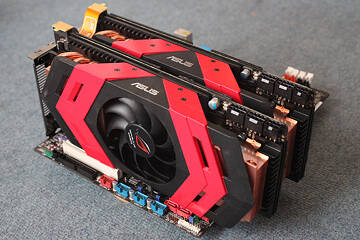 47
47
ASUS ARES CrossFire Review
(47 Comments) »Introduction

ASUS was very kind and sent us two of their ARES monster graphics card for testing in CrossFire. With a price of around $2000, such a setup can only be achieved by anyone with deep pockets and a deep love for technology. If you haven't done so yet, please check out the single card review first, as this review will only focus on the CrossFire combination of the ARES.
Two of these beautiful babies basically cover the whole slot area of your motherboard, each taking three slots for a total of six. If you take another look, check out the massive number of power connectors required. A total of four 8-pin and two 6-pin power cables are sure to provide enough juice to the system for even your wildest overclocking dreams.
In this review we will investigate the performance of two ARES cards, but we will also take a look at possible upgrade paths involving the ARES. For example, if you have already have a HD 5970, how much can be gained from adding ARES to that? What if you come from a HD 5870?
Test System
| Test System | |
|---|---|
| CPU: | Intel Core i7 920 @ 3.8 GHz (Bloomfield, 8192 KB Cache) |
| Motherboard: | Gigabyte X58 Extreme Intel X58 & ICH10R |
| Memory: | 3x 2048 MB Mushkin Redline XP3-12800 DDR3 @ 1520 MHz 8-7-7-16 |
| Harddisk: | WD Raptor 740ADFD 74 GB |
| Power Supply: | akasa Power Xtreme AK-P120FG-BK 1200W |
| Software: | Windows 7 64-bit |
| Drivers: | NVIDIA: 195.62 GTX 470 & 480: 257.15 ATI: Catalyst 10.3 |
| Display: | LG Flatron W3000H 30" 2560x1600 |
- All video card results were obtained on this exact system with the exact same configuration.
- All games were set to their highest quality setting
- 1024 x 768, No Anti-aliasing. This is a standard resolution without demanding display settings.
- 1280 x 1024, 2x Anti-aliasing. Common resolution for most smaller flatscreens today (17" - 19"). A bit of eye candy turned on in the drivers.
- 1680 x 1050, 4x Anti-aliasing. Most common widescreen resolution on larger displays (19" - 22"). Very good looking driver graphics settings.
- 1920 x 1200, 4x Anti-aliasing. Typical widescreen resolution for large displays (22" - 26"). Very good looking driver graphics settings.
- 2560 x 1600, 4x Anti-aliasing. Highest possible resolution for commonly available displays (30"). Very good looking driver graphics settings.
BattleForge

BattleForge, a card based RTS, is developed by the German EA Phenomic Studio. A few months after launch the game was transformed into a Play 4 Free branded game. That move and the fact that it was included as game bundle with a large number of ATI cards made it one of the more well known RTS games of 2009. You as a player assemble your deck before game to select the units that will be available. Your choice can be from forces of Fire, Frost, Nature and Shadow to complement each other.
The BattleForge engine has full support for DX 9, DX 10 and DX 10.1, we used the internal benchmark tool to acquire our results.





Our Patreon Silver Supporters can read articles in single-page format.
Apr 2nd, 2025 01:47 EDT
change timezone
Latest GPU Drivers
New Forum Posts
- Microprose: Falcon 5.0 - Well under development- yeay (6)
- Whats the Deal with the 570 nvidia drivers ? (7)
- Build complete! Any thoughts on undervolting? (22)
- RX 9000 series GPU Owners Club (97)
- RTX 3090 is still a good card? (35)
- What's your latest tech purchase? (23446)
- Nvidia culls 10bit video support on 50 series. (0)
- Help me pick a UPS (16)
- Which version of GPU-Z for Windows XP Pro 32 bit? (1)
- HIS 7870 IceQ Turbo 2GB EFI BIOS for Mac OS (0)
Popular Reviews
- DDR5 CUDIMM Explained & Benched - The New Memory Standard
- Sapphire Radeon RX 9070 XT Pulse Review
- SilverStone Lucid 04 Review
- ASRock Phantom Gaming B850 Riptide Wi-Fi Review - Amazing Price/Performance
- Palit GeForce RTX 5070 GamingPro OC Review
- Gigabyte GeForce RTX 5080 Gaming OC Review
- Sapphire Radeon RX 9070 XT Nitro+ Review - Beating NVIDIA
- Samsung 9100 Pro 2 TB Review - The Best Gen 5 SSD
- Assassin's Creed Shadows Performance Benchmark Review - 30 GPUs Compared
- be quiet! Pure Rock Pro 3 Black Review
Controversial News Posts
- MSI Doesn't Plan Radeon RX 9000 Series GPUs, Skips AMD RDNA 4 Generation Entirely (146)
- Microsoft Introduces Copilot for Gaming (124)
- AMD Radeon RX 9070 XT Reportedly Outperforms RTX 5080 Through Undervolting (119)
- NVIDIA Reportedly Prepares GeForce RTX 5060 and RTX 5060 Ti Unveil Tomorrow (115)
- Over 200,000 Sold Radeon RX 9070 and RX 9070 XT GPUs? AMD Says No Number was Given (100)
- NVIDIA GeForce RTX 5050, RTX 5060, and RTX 5060 Ti Specifications Leak (96)
- Retailers Anticipate Increased Radeon RX 9070 Series Prices, After Initial Shipments of "MSRP" Models (90)
- China Develops Domestic EUV Tool, ASML Monopoly in Trouble (88)


